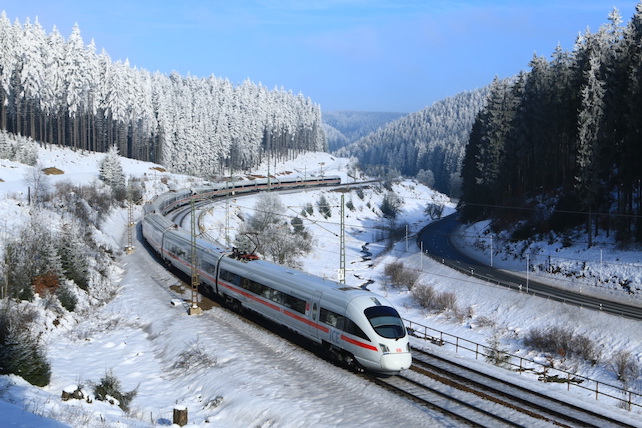
Dan Elkan is passionate about persuading people to be more ecologically aware in their day-to-day lives and to help save the planet. He founded Snowcarbon in 2009, a website about how to travel to the Alps by train instead of plane, making the journey part of the holiday while slashing carbon emissions.
Austria…by train…from the UK? It’s surely too far – or so I used to imagine. How wrong I was. Over the past 20 years, I’ve proved it to myself many times, travelling to resorts all over Austria with daytime or overnight journeys, and what a pleasure it is.
Overnight trips start with a high-speed journey from St Pancras to Brussels. There, you alight from the Eurostar and cross to the adjacent platform to catch the ICE train to Cologne.
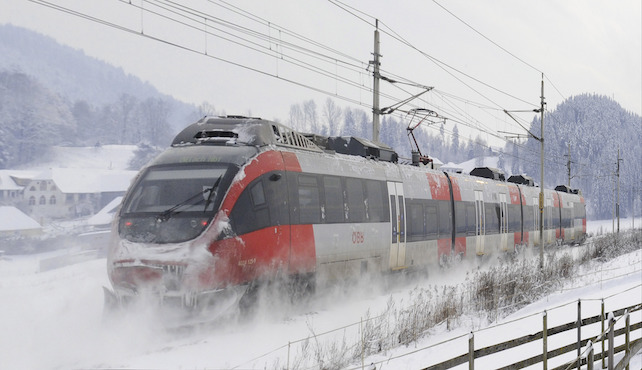
ICE trains are spacious. Huge windows offer vistas of ever-changing scenery. There’s a proper restaurant where a waiter comes to your table and takes your order. The menu is impressive – yet inexpensive. You eat off real plates with real cutlery. Draft beer and good wine are served. The spaghetti bolognaise is delicious, the mixed salad a delight.Compare that to trains in the UK, where the culinary experience is usually limited to a trolley of mediocre sandwiches trundled down the aisle. Dining on at 230km/h the ICE feels like being on a different planet. You may not want to get off.
When you do, at Cologne, there’s time to marvel at the 157-metre-high cathedral, conveniently located right opposite the station. Right there too, is Gaffel am Dom, a cavernous restaurant and beer hall with traditional dishes such as Bratwurst.
Then, in Germany, it’s time to board the NightJet. Although this may sound like an overnight flight, you are firmly and smoothly on rails, heading through the night to the Alps. Overnight accommodation is in couchettes and compartments for six, four, three, two people – and even individual compartments for one. Some come with en-suite washing and shower facilities, too.
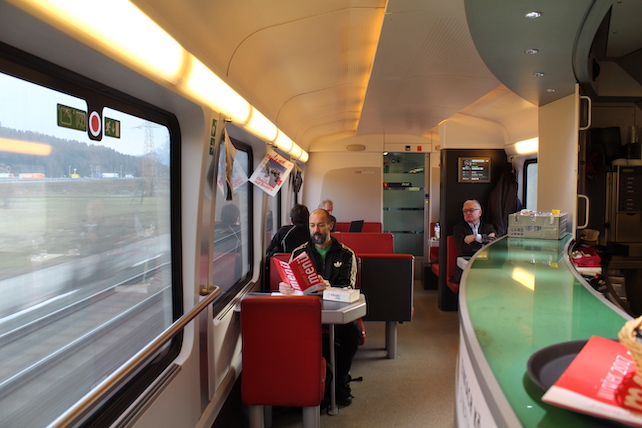
The next morning, the NightJet arrives at Kufstein, Worgl, Jenbach and Innsbruck stations, all of which have with a host of nearby Tirolean ski resorts. Switch train at one of those stations and you can venture further afield, too. One of the major plus factors about reaching the Austrian Alps by rail is that most of the resorts either have a train station in the village itself, or are only a short bus or taxi ride from one.
An alternative option is to travel by Eurostar from London to Paris Gare du Nord. by Eurostar. From there you can board a NightJet to Salzburg, giving you easy access to ski resorts in Salzburgerland. This route is longer overall than the via-Brussels route to the Tirol, but viable nevertheless.
Daytime travel is possible, too. The journey to St Anton am Arlberg is one of the most scenic ones imaginable. Take a Eurostar to Paris Gare du Nord and then a TGV train from Paris Gare de Lyon to Zurich, and the Railjet St Anton. En route, you’ll have a ringside seat of the Alps as you skirt Lake Zurich and Lake Wallensee. The journey into Austria through the Arlberg Valley is magnificent, with mountains and quaint villages on either side. And there are plenty of daytime journeys to other resorts in Austria, using a combination of Eurostar, ICE and Austrian trains.
Journeys to Austria by train take longer than flying. But they create only about a tenth of the carbon emissions of equivalent journeys by plane. You are rewarded with a journey that feels part of the holiday – quality of time spent with friends or family; an adventure, but a comfortable one – on your way to magical villages full of snow.
How to find schedules and tickets
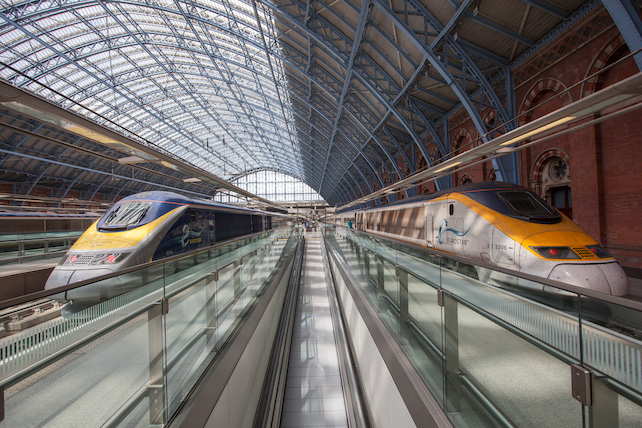
One of the best websites for searching specific rail schedules is Deutsche Bahn. A very useful site for advice on travel to Austria, and how to book, is Seat 61. When it comes to booking tickets between the UK and the Austrian Alps, it’s best to use a rail-booking agent, rather than trying to book online.
The reason for this is that – currently at least – online ticket-booking websites like Trainline, Rail Europe and Omio simply can’t display the most convenient journeys. This is due to a failure of the algorithms that power their searches to show you schedules and available tickets at the same time, causing searches to offer odd results or draw a blank.
However, experienced rail-booking agents such as The Travel Bureau, Trainseurope and International Rail use different systems, have plenty of experience and will give you a human-centred approach to choosing the best and most suitable options.
Here are a few of the resorts easily reached by train, but there are many more:.
St Anton am Arlberg
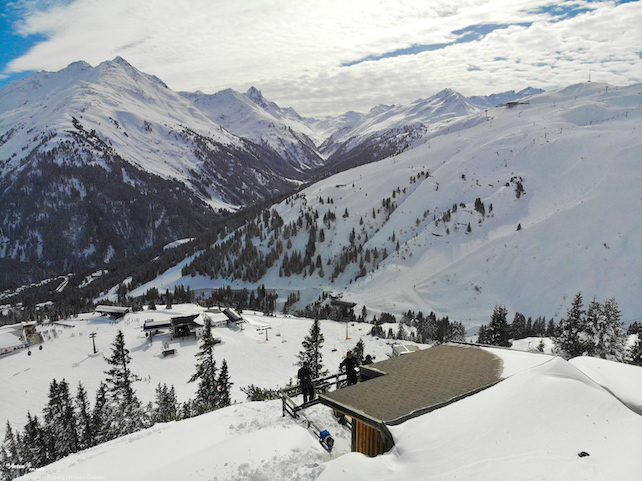
In 2016, the Arlberg ski area finally linked together with the Flexenbahn lifts, creating a vast ski area – one of the world’s biggest and best. But the new lifts didn’t change St Anton‘s character. This is still primarily a resort for skiers who want to be challenged. It’s now much easier to ski over to the gentler terrain of Lech-Zurs with their smart hotels, but St Anton is the steeper, tougher, livelier end of the area. The resort is full of qualified ski guides of the highest level, so book one if you’re heading off-piste.
Another thing that changed in recent years is the quality of the food. At the top end, there are some great chefs working here. What’s more, the cheaper eats tend to be better value than in St Anton’s A-list rivals in France.
Example journey: Depart London St Pancras on the 07:55 Eurostar to Paris Gare du Nord. Switch station and take the 12:22 TGV from Paris Gare de Lyon, changing at Zurich to arrive at St Anton at 19:01.
Hopfgarten
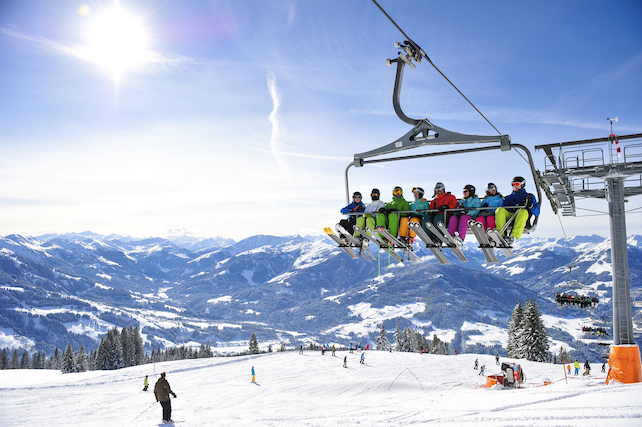
Hopfgarten is an attractive market town with a yellow-painted church as its focal point. It is also one of the nine resorts that makes up the SkiWelt area, with its 90 lifts and 280km of intermediate pistes. Other linked resorts – Westendorf, Itter and Brixen-im-Thale – line the valley around the dome-shaped massif. They in turn link with Kirchberg and Kitzbuhel. Then there are yet more resorts that access the ski area: Going, Ellmau, Scheffau, Soll. As a result, early-morning lift queues are rare.
Hopfgarten is known for having the sunniest slopes in the area, with well-groomed pistes that are ideal for families and beginners. A modern eight-seater gondola whisks you directly from the resort to the summit of the Hohe Salve at 1829m, the highest point in the ski area. From there, a memorable run drops back down to Hopfgarten.
Example journey: Depart London St Pancras on the 15:04 Eurostar to Brussels. Then take the 18:05 ICE to Cologne and then the 22:16 NightJet, arriving Wörgl at 08:37. From there it’s 12 minutes by taxi.
Alpbach
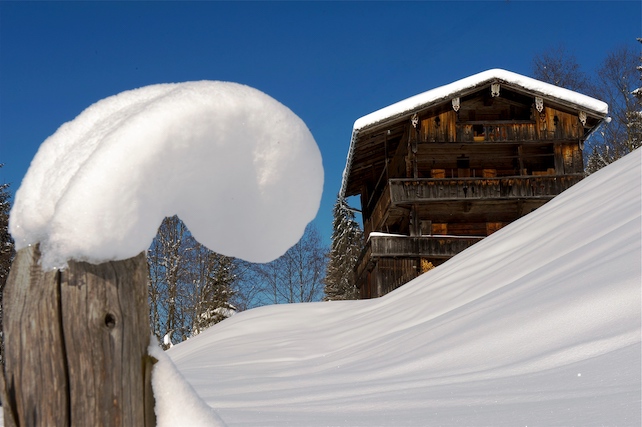
Alpbach is one of the prettiest ski resorts in the Alps and it is not just a tourist destination, but a place where real people still farm, live and work. What’s more, for anyone who’s used to the eye-watering prices of Europe’s A-list resorts, the cost of holidaying here comes as a pleasant surprise. In a gorgeous hotel like the Boglerhof, a junior suite costs less than a standard room in three-star hotel in Meribel, France.
All of this used to come with a rather limited ski area until 2012 when Alpbach linked with the Wildschönau ski area to form Ski Juwel. The result is a medium-sized area that offers excellent intermediate skiing, including one black run.
There is one important caution, though: the altitude. Almost all the skiing here is below 2000m, but remember that the more easterly latitude plays its part: don’t compare ski resort and area heights to France where higher altitudes are generally snow safe. Snow guns cover 85% of the pistes and, because a lot of the skiing is below the treeline, visibility is good in snowy weather. The mix of farmland, forest and smooth mountains topped by craggy peaks, makes for a less severe setting than the high-altitude resorts elsewhere. Summer pasture land requires a minimal amount to snow for skiing compared to rocky terrain elsewhere.
But all the same, Ski Juwel’s cover is vulnerable to mild weather – and the snow on the lower pistes can get slushy by mid-afternoon during a thaw. For the best chance of good top-to-bottom cover, ski it in January or February.
Example journey: Depart London St Pancras on the 15:04 Eurostar to Brussels. Then take the 18:05 ICE to Cologne and then the 22:16 NightJet, arriving Jenbach at 08:53. From there it’s 20 minutes by taxi, or 40 minutes by bus.
Zell am See
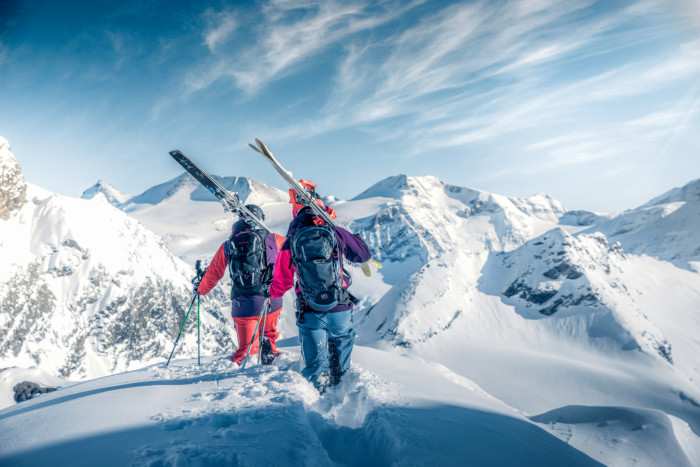
Set in a wide valley beside a beautiful lake, Zell am See has been an important town in the Salzburgerland since the Middle Ages. Its medieval buildings and cobblestone streets are still there, along with newer hotels and smart boutiques, making it a romantic base for couples.
Immediately above town is the 2000m Schmittenhohe – which offers a mix of intermediate-friendly pistes both above and below the treeline. Meanwhile, 13km to the south lies the other main ski sector, Kaprun with its Kitzsteinhorn mountain. Here, the slopes rise to a snowsure 3030m, offering skiing not just in winter, but in autumn and the first half of summer too. In fact, it’s one of the best areas for early-season skiing we know of. These days the ski area links (with a short ski bus journey) to the mighty 270km Skicircus Saalbach Hinterglemm Leogang Fieberbrunn.
Access to Zell am See is unusually good for a ski resort. It’s only 60 minutes’ drive from Salzburg airport and there are regular shuttle buses, too. Trains from Salzburg’s main railway station into the middle of town take 90 minutes. Parents with young children, and weekend skiers, will like the short transfer times: and day trips back into Salzburg are perfectly feasible for anyone who wants a little time off the slopes.
Example journey: Depart London St Pancras on the 15:04 Eurostar to Brussels. Then take the 18:05 ICE to Cologne, then the 22:16 NightJet to Wörgl and the 09:14 InterCity to arrive Zell am See at 11:00.
Bad Gastein
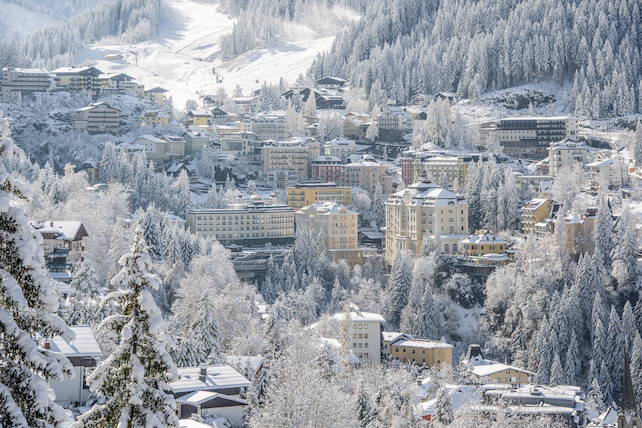
The ancient watering-hole of Bad Gastein is the original and most important of the four resorts dotted along the attractive Gastein valley, which sits on a giant reservoir of warm thermal water, a 90-minute drive from Salzburg. An extraordinary 23 million litres of this healthy water bubbles up each day from 17 springs. This is piped to the main hotels and into the public indoor and outdoor baths. You can even soak at the foot of the pistes while the snow falls around you.
The resort hotels are a mix of revamped classic Habsburg Empire style and glossy modern, set on unusually steep gradients. You’ll also find smart boutiques and expensive jewellery shops here. The valley is best suited to intermediates wanting a large ski area with plenty of challenge.
Example journey: Depart London St Pancras on the 14:31 Eurostar to Paris Gare du Nord. Then take the 18:58 NightJet to Salzburg, and then the 08:12 InterCity to arrive Bad Gastein at 09:41.
Schladming
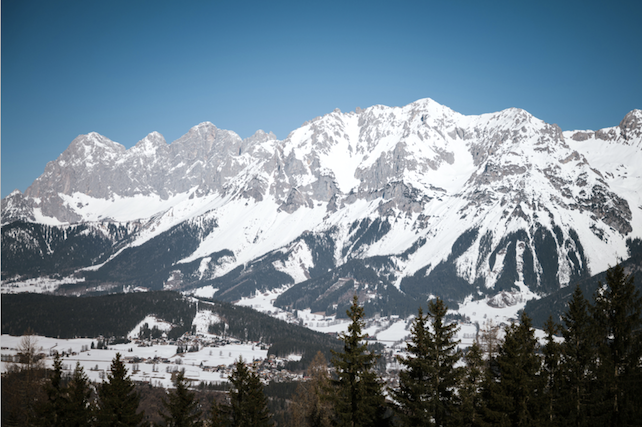
Schladming is a medieval town with an industrial and cultural life of its own rather than a village that has expanded into a ski resort. It has two beautiful Romanesque and Gothic churches and a magnificent 18th-century town square. It makes a charming base from which to explore the large intermediate playground included in the 860km Skiverbund Amade lift pass, with glacier skiing on the Dachstein Glacier and extensive cross-country trails nearby.
This is a popular resort with the Austrians, and the slopes can be crowded during national school holidays in February. For quieter slopes, either come here in low season or stay in one of the surrounding villages of Haus, Pichl, Rohrmoos, or Ramsau.
Example journey: Depart London St Pancras on the 14:31 Eurostar to Paris Gare du Nord. Then take the 18:58 NightJet to Salzburg, and then the 08:16 InterCity to arrive Schladming at 09:50.
Mayrhofen
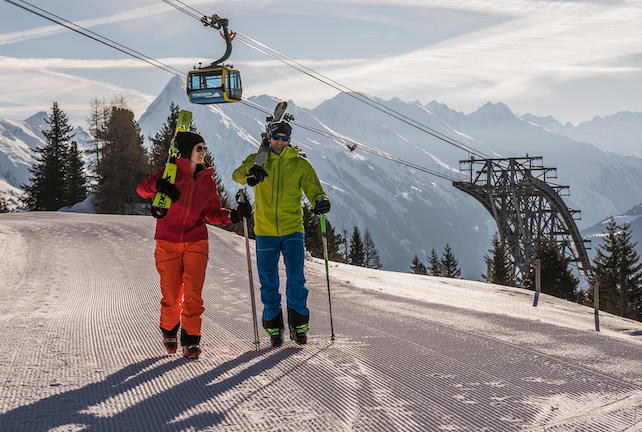
Mayrhofen is a large resort set below the normal winter snowline with a ski area that is split between two separate mountains. You can’t ski between them and you can only ski back down into town on a single piste. Offering 136km of pistes, the local ski area is modest in size, too. But that’s not all there is.
A few important details keep bringing British and Dutch skiers back time and time again. First is resort access: it’s just 75 minutes’ drive from Innsbruck Airport. Secondly: the slopes immediately above Mayrhofen are just a fraction of what’s on offer in the entire Zillertal Valley. There are 668km of pistes to be skied, with lots of off-piste in between. Thirdly: it’s great for beginners, with an excellent area of nursery slopes at the top of the gondola at Penken and set well away from the other pistes.
Example journey: Depart London St Pancras on the 15:04 Eurostar to Brussels. Then take the 18:05 ICE to Cologne and then the 22:16 NightJet to Jenbach and then the 09:11 regional train to Mayrhofen, arriving 10:01.


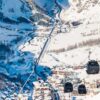







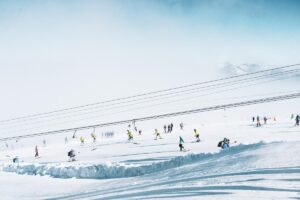
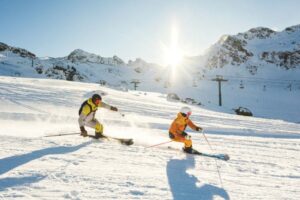

Add Comment